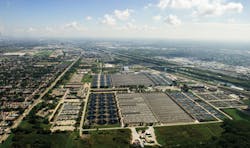Nutrient Recovery Technology Transforms World's Largest Wastewater Treatment Plant
By Art Haddaway, WaterWorld Editor
In recent years, a number of groundbreaking developments in the field of wastewater treatment have paved the way for utilities to better manage and improve operations. Biological technologies, advanced reuse and recycling techniques and progressive green-based practices have led to various economic, environmental and societal benefits that can help reduce costs, conserve energy, sustain the environment, and improve customer service.
One resourceful process currently trending in the wastewater industry and bringing these benefits to light is nutrient recovery. Nutrient recovery is the practice of recovering nutrients such as nitrogen and phosphorus from used water streams that would otherwise be discarded and converting them into an environmental friendly fertilizer used for ecological and agricultural purposes. This process helps clean the effluent by removing these nutrients and ultimately transforms them into an efficient, reusable feedstock.
Wastewater typically contains a large amount of nutrients -- particularly phosphorus -- that can pose a harmful threat to infrastructure and the environment, causing problems such as eutrophication in waterbodies and a buildup of struvite in mechanical systems. By utilizing nutrient recovery, wastewater plants can mitigate these challenges while improving water quality and meeting stringent phosphorus discharge limits.
The recovery process also offers municipalities an opportunity to generate revenue while providing agricultural businesses with refined, usable phosphorus -- an increasingly scarce natural resource. Moreover, it enables wastewater entities to serve as more than just treatment facilities but ultimately as resource recovery agents, transforming the perception of traditional wastewater treatment.
Such is the case with the Metropolitan Water Reclamation District (MWRD) of Greater Chicago's Stickney Water Reclamation Plant. Located in the city of Cicero, Ill., the 85-year-old facility -- the largest secondary wastewater treatment plant in the world -- will soon begin reclaiming large amounts of nitrogen and phosphorus using an innovative nutrient recovery system from Vancouver-based Ostara Nutrient Recovery Technologies Inc. The new system will ultimately help the facility safeguard vital water resources and improve overall operations.
"We're out there really trying to test and see what can transform this market in terms of lowering our energy usage, recovering resources and providing a return on investment (ROI) for our constituents," said David St. Pierre, MWRD executive director. "We started talking about how we can actively address nutrients, in particular phosphorus, in our waterways," he said. "We looked at the Stickney plant to see if it was a candidate for the Ostara process, and we decided that it was. So being a water quality agency that supports improving the environment, we just felt that was the right thing to do."
The Stickney plant currently treats up to 1.4 billion gallons of water per day (MGD) and serves 2.4 million people in the Chicago areas and the surrounding suburbs. Scheduled for completion in the fall of 2015, the Ostara project will equip the facility with the capacity to produce between 10,000 and 15,000 tons of enhanced efficiency fertilizer annually, making it the largest project of its kind in the world. Ostara will provide all equipment for the program as well as offer operations and maintenance assistance to MWRD once completed. In addition, the company will partner with Overland Park, Kansas-based Black & Veatch, who will provide design, procurement and construction services.
MWRD opted to implement Ostara's technology at the Stickney plant given that it is currently incorporating biological phosphorus removal. "Stickney is the easiest plant to get there. We have carbon at the plant that allows us to have phosphorus uptake," said St. Pierre.
Through its proprietary Pearl® process, Ostara diverts nutrient-rich wastewater streams into a fluidized bed reactor and combines it with compounds such as magnesium chloride and, on occasion, sodium hydroxide, where small struvite "seeds" are formed. This reactor controls the chemistry formation of the seeds and ultimately recovers them in the form of highly pure crystalline pellets, which can grow in diameters of 1.0 to 3.5 mm. This finished material is a high-grade, slow-release end-product that Ostara harvests, dries, packages, and markets as a commercial fertilizer called Crystal Green®.
"What Ostara is doing is providing a third exit for phosphorus from the system," said Steve Wirtel, Ostara senior vice president of technology solution sales. "We've taken this vicious cycle of removal in the biology (release in the digester and recycle back to the plant) and we've converted that into a virtuous cycle where you have … recovery in our system because what we're making is struvite but in an engineered form."
Ostara plans to purchase the Crystal Green product at $400 per ton from MWRD, which should generate enough revenue to offset the costs of operation at the Stickney plant. Further, St. Pierre noted that he's confident once Ostara's nutrient recovery process is in place, MWRD can recover at least 10,000 tons of Crystal Green product per year and generate $2.5 million annually in net revenue from the sale of the fertilizer. "Using the nutrient recovery model and using biological phosphorus in our current footprint, we are significantly reducing costs by a factor of 10 for our constituents," he said.
MWRD will invest upwards of $30 to 35 million for the project, with a payback of about three to five years, or what would be about $8 or 9 million annually spent in chemicals, said Wirtel. "On a lifecycle cost basis, the costs savings from that utility are going to be on the order of three to five times what they would have spent in chemicals to break that phosphorus recycle and prevent that struvite formation in their system," he said. Ostara's project represents a capital investment, he explained, and "once they pay it back, it will continue to save operating costs and generate revenue for them in perpetuity."
When it comes to phosphorus, one of the main issues Chicago and other cities in the Midwest face is that utilities such as wastewater treatment plants release nutrient-rich effluent into the Mississippi River, which flows into the Gulf of Mexico. There it can potentially contribute to the presence and growth of algal blooms and the 7,000-square-mile hypoxic zone that has developed off the coast of Louisiana and Texas. MWRD recognized this issue and recently imposed a voluntary phosphorus limit of 1 mg/L at the Stickney facility. Ostara's technology will help them meet that goal.
"The real challenge with phosphorus is that, unlike nitrogen, it can only exist in a solid or aqueous form," explained Wirtel. "So the only way to get it out of a plant is the effluent or in the biosolids, and if you have restrictions on the amount going out in the effluent, then you have to convert it into a solid and get it out with the biosolids," said Wirtel. Ostara's nutrient recovery system capitalizes on this process and will transform the way the Stickney plant handles nutrients, removing upwards of 90 percent of the phosphorus and 40 percent of the ammonia from its sludge dewatering liquid, according to Ostara.
MWRD noted that it does not expect construction to interrupt the Stickney plant's operation and that it will only require short-duration shutdowns of ancillary processes, as it will connect to the existing treatment plant. The District's other two regional wastewater facilities -- the Calumet plant and O'Brien plant -- currently operate on the scale of around 500 MGD, and between the three utilities, MWRD also expects to achieve 40 to 45 percent of its phosphorus reduction goal for the state of Illinois, St. Pierre noted.
"Phosphorus is a diminishing resource. We have to figure out ways to recover these nutrients -- other than mining -- because that source is going away. If we don't have phosphorus, we're not going to grow food for this planet," said St. Pierre. "In terms of a worldwide paradigm, we're going to have to start thinking like this on a grander scale and recover these resources where they're at and not necessarily in traditional ways."
"We're closing that loop on phosphorus," added Wirtel. "We're going to where the material is, which is in municipal wastewater plants, and we're recovering that phosphorus, keeping it out of the water environments, and returning it back to the agronomic environments where it belongs."
More WaterWorld Current Issue Articles
More WaterWorld Archives Issue Articles






